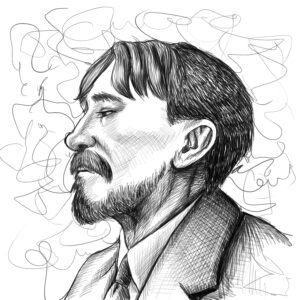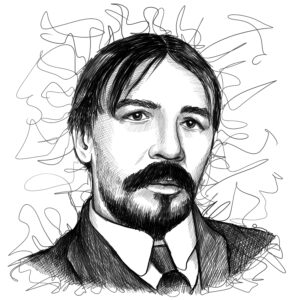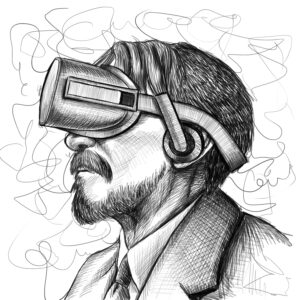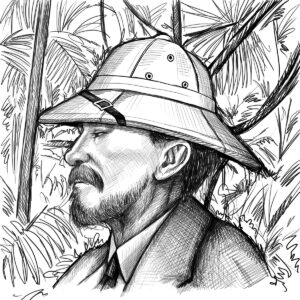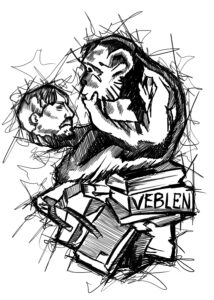 In 1967, Desmond Morris wrote The Naked Ape: A Zoologist’s Study of the Human Animal. In this work, Morris examined human behavioral patterns within the larger animal kingdom. He categorized these behaviors into six fundamental drives: sex, rearing, exploration, fighting, feeding, and comfort—each rooted in our evolutionary past yet expressed in the modern context of daily life. However, the foundations of this “Naked Ape” perspective trace back more than a century earlier, beginning with Charles Darwin’s On the Origin of Species. Darwin’s landmark study was the first biological challenge to centuries-old philosophical and theological views of human nature.
In 1967, Desmond Morris wrote The Naked Ape: A Zoologist’s Study of the Human Animal. In this work, Morris examined human behavioral patterns within the larger animal kingdom. He categorized these behaviors into six fundamental drives: sex, rearing, exploration, fighting, feeding, and comfort—each rooted in our evolutionary past yet expressed in the modern context of daily life. However, the foundations of this “Naked Ape” perspective trace back more than a century earlier, beginning with Charles Darwin’s On the Origin of Species. Darwin’s landmark study was the first biological challenge to centuries-old philosophical and theological views of human nature.
In 1899, American economist Thorstein Veblen pioneered the connection between these inherent human behaviors and our socioeconomic macrocosms. Across his body of work, Veblen illustrated how our evolutionary instincts shape the framework of socioeconomics. He introduced a biological perspective on human nature into the field of economics, broadening it beyond its narrow scope to encompass how humans provision their needs. While the biological sciences available to Veblen in the late 19th century may seem primitive by contemporary standards, subsequent advances in biology and the behavioral sciences have only reinforced his insights.
A New Homo Economicus
Veblen’s “Naked Ape” socioeconomics shattered the foundations of conventional economic thought. The long-standing notion of homo economicus—the rational, self-interested economic actor—was largely a product of 17th- and 18th-century philosophers, and this conceptual construct remains ingrained in socioeconomic thinking today. Despite Veblen’s insights, mainstream economists continue to adopt this flawed conception of human nature, whether they lean Capitalist, Socialist, or Marxist. Veblen argued that socioeconomic phenomena are not static but instead represent complex, chaotic systems shaped by the intertwined forces of human biology, culture, and technology—thus demanding a qualitative approach. He was a brilliant master at seeing through the illusions human beings create and package as mythology, theology, and ideology.
Veblen’s first book, The Theory of the Leisure Class, launched his extensive body of work connecting human biology to our socioeconomic reality. These powerful biological forces often remain hidden from us by our own ability to rationalize our behaviors. While Veblen centered his analysis on Western socioeconomic civilizations, his core understanding of human nature applies to all cultures. He specifically used the American socioeconomic environment surrounding him as a primary case. Though his work is now more than a century old, the trends he uncovered have only grown more relevant, collectively defining many aspects of today’s American socioeconomic reality.
The lexicon of Veblen’s “Naked Ape” socioeconomics situates human instincts within the context of an anthropological cultural structure. Veblen did not define human nature as purely biological; rather, it is interwoven with social and technological influences. Our biological makeup is filtered, directed, and expressed through norms and conventions that shape any particular socioeconomic system. These powerful “force fields” of human behavior often operate below the radar of traditional economics; yet they underlie all socioeconomic activity. Over time, our nature-and-nurture-driven behaviors evolve in response to changing circumstances and environments.
Our Instinctual Patterns
From a species-level perspective, Veblen identified three primary “good” instincts: Parental Bent, Idle Curiosity, and Workmanship. He distinguished these based on their patterns in a socioeconomic context, noting that in reality they are closely intertwined. Our Idle Curiosity and Workmanship instincts constitute the matter-of-fact behaviors that form the bedrock of collective knowledge, science, and technology. Their byproducts are evolutionary and cumulative, continually building upon a common stock of technological capabilities and shared understanding. The more knowledge, tools, and techniques we have, the more innovations arise. Veblen referred to the body of knowledge and technology within a community as “The State of the Industrial Arts.”
Veblen’s Parental Bent instinct derives from our nurturing of the young. Broader than simple parenting, it encompasses the spectrum of cooperative and altruistic behaviors.
Beneath these “good” instincts lies what Veblen saw as the 800-pound gorilla of human behavior: our predatory instinct, inherited from our animal kingdom origins. This predatory drive manifests as aggression, violence, competitiveness, and exploitation in raw form, but human intelligence allows us to channel or disguise it in many ways. In a socioeconomic context, it surfaces as honor, emulation, esteem, and respect, among other expressions.
The Leisure Class
Veblen identified the elite within any socioeconomic system as the “Leisure Class.” The term captures the defining trait of these elites: exemption from what he called “industry,” or the labor required to meet life’s basic needs. In using the phrase Leisure Class, Veblen referred to the avoidance of the physical work necessary for securing daily necessities. Because of their place atop the socioeconomic food chain, the Leisure Class is relieved of this “burden” of industry. Over time, the composition and characteristics of the Leisure Class evolve in tandem with the State of the Industrial Arts and the cultural context it engenders.
Habits and Institutions
At the core of human modus operandi is our capacity to transform thoughts and actions into habitual “algorithms.” We are creatures of habit, streamlining repetitive mental and physical processes into automatic routines. These habits evolve and adapt over time, responding to new circumstances, influences, or technologies. They become codified within cultures, eventually forming norms, conventions, and institutions. Each new situation is a variation on prior habits.
The discipline of habits and institutions furnishes the underlying logic for conventions, customs, and prescriptions of social behavior. Socialization involves learning these institutional patterns. Although habits and institutions do change, they lag behind newly emerging knowledge and technologies. Institutions are the products of selective and adaptive processes that shape prevailing attitudes, aptitudes, and animisms. Human societies replicate themselves across generations by adhering to these institutions, which function as accepted canons of behavior.
Ceremonial and Instrumental Behaviors
All human communities operate on two overarching behavioral patterns. Ceremonial behaviors spring from archaic rituals, status hierarchies, and sacred institutions. Instrumental behaviors, by contrast, are driven by practicality, factual inquiry, and curiosity. The relative balance of these two patterns within a community defines its socioeconomic dynamism.
Ceremonial conventions articulate mores, taboos, roles, and rites that collectively shape any socioeconomic structure. They rest on a form of mystical potency or prowess embraced by the entire population. Instrumental behaviors, meanwhile, operate within these ceremonial constraints. Ceremonial behaviors often claim a causal relationship to the very technological and instrumental processes that produce actual knowledge and innovation. Because these two patterns are so deeply interwoven, most people struggle to see their dichotomy; instrumental behaviors invariably become fused with ceremonial ones to gain legitimacy.
Influences of the Machine and Digital Processes
Veblen studied how the state of the industrial arts affects human behaviors. In the industrial era, he highlighted the emergence of the “Machine Process” as a new form of everyday regimentation. The systemization, mechanization, and standardization required by industrial systems cultivated a more matter-of-fact outlook in broader society, enforcing new regimens in timekeeping, work rules, and systematic thinking. As industrial processes evolved, human activity accelerated accordingly. Veblen showed how this Machine Process was a powerful behavioral force, supplanting earlier agrarian patterns that were more closely aligned with natural cycles.
Building on Veblen’s concept of the Machine Process, we can identify a subsequent force: the Digital Process. This technological revolution has arguably had an even greater impact on our behaviors than its industrial predecessor. Digital processes have reshaped virtually every aspect of daily life. Like the Machine Process before it, the Digital Process imposes its own powerful regimentation—though we have yet to grasp its full ramifications. Beyond merging with mechanical methods, this always-on, real-time digital ecosystem creates unprecedented channels for human behavior and cultural transformation.
Summary
Veblen’s key ideas about humanity’s modus operandi have endured. There is a growing body of evidence that human behavior arises from a dynamic interplay between biology and the environment—where “environment” includes everything from culture to physical surroundings. The essence of Veblen’s new profile of human nature was to hold a mirror to ourselves and the socioeconomic realities we produce.
Veblen did not (and perhaps could not) offer tidy “solutions,” since his mission was to identify and interpret these human behavioral phenomena. Human behavior is exceedingly complex, shaped by intertwined biological and environmental factors, and can be understood only at a holistic level. Veblen’s pioneering, transdisciplinary approach, what he called a “cosmological” perspective on socioeconomics, remains revolutionary today.
Lorem ipsum dolor sit amet, consectetur adipiscing elit. Ut elit tellus, luctus nec ullamcorper mattis, pulvinar dapibus leo.
